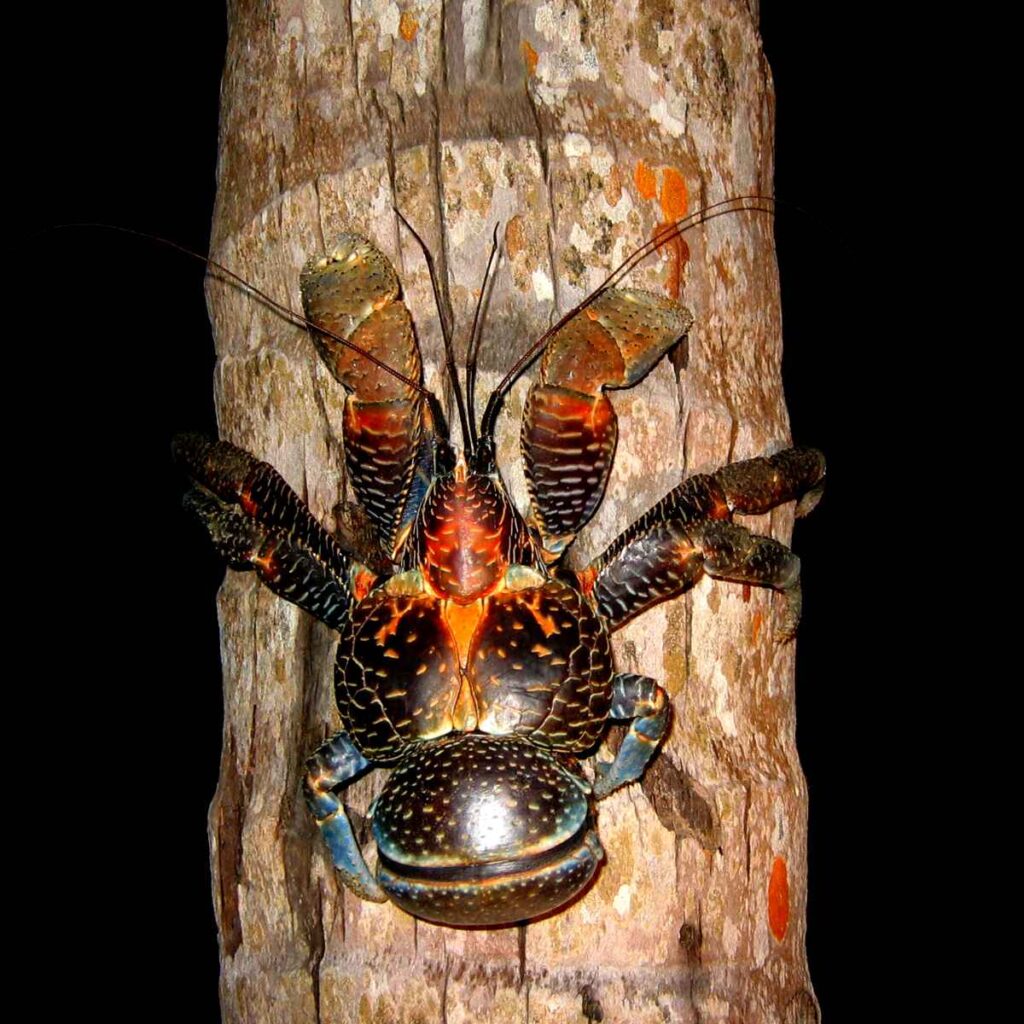Last Reviewed and Updated on February 11, 2023
Their enormous size might send shivers down your spine. Coconut crabs have a few accolades they can claim, learn more about this peculiar species, from the basics and all the way through to some of the most fascinating facts about coconut crabs.

About Coconut Crabs
Coconut crabs (Birgus latro) are large land hermit crabs, mostly found on the islands in the Indian Ocean and parts of the Pacific ocean. It is the only species in its genus.
Their coloration varies from island to island, ranging from orange hues to blue hues, with blue or purple-blue being the most common.
Coconut crabs are omnivores and opportunistic feeders. They eat fleshy fruits, nuts, seeds, and live and dead animals. They eat coconuts, but they aren’t a significant part of their diet.
These crabs mate and reproduce on land. Females carry the fertilized eggs on the underside of their abdomen, and once the larvae hatch, the female releases them into the ocean. Over time, larvae grow and molt into juvenile crabs and slowly return to land.
Coconut crabs are listed as vulnerable, mostly due to them being hunted for food and habitat loss.
Interesting Facts About Coconut Crabs
Let’s delve into the interesting facts about coconut crabs.

1. Coconut crabs are the largest land arthropod in the world
They grow to impressive sizes; they can reach up to 3 ft 3 in / 1 m in length and can weigh up to 9 lb / 4.1 kg. They are the largest land arthropod, a phylum of animals that includes invertebrate animals with an external exoskeleton (bugs, crabs, shrimp…).
It isn’t the largest living arthropod when you consider marine animals. The largest known is the Japanese giant spider crab.
2. Young coconut crabs wear shells for protection
Coconut crabs are related to hermit crabs. Much like hermit crabs, juvenile coconut crabs use empty shells for protection. As they mature, they develop a tough exoskeleton on their abdomens and no longer require the shells for protection.
3. When they molt, they hide in deep burrows
Adult coconut crabs may be protected with their hard exoskeleton, but when they molt, they are vulnerable.
These crabs molt annually (shed old exoskeletons and develop new, larger ones). The new exoskeleton is soft, and it may take weeks to harden. While it is soft, the coconut crabs are vulnerable, so they dig a burrow in which they hide until their exoskeleton hardens.
4. Adults can drown in the water
As adults and juveniles, coconut crabs live on the land. They will drown if left in the water for too long.
They have a branchiostegal lung, an organ that is something in between the lungs and gills, which they use to breathe. With this organ, they breathe air and can’t breathe underwater, although this organ must be kept moist to function.
This crab also has a set of gills; these gills are small and rudimental and don’t provide enough oxygen underwater.
5. They have a keen sense of smell
Coconut crabs have a great sense of smell which they use to locate their food. Their sense organs are similar to those of insects and are an excellent example of convergent evolution (source), where two species or types of animals who aren’t closely related developed similar adaptations.
6. They can drop coconuts from trees
Coconuts are part of their diet (although not a significant part). They can open the coconuts with their pincers, although it may take days. Surprisingly, given their size, these crabs can also climb trees. They have been known to open coconuts by dropping them from trees.
7. Coconut crabs can be toxic
They are edible and still hunted for food. They aren’t poisonous by nature but may become poisonous depending on what they eat.
8. They are also called robber crabs
Coconut crabs got their other common name because of their feeding habits; everything organic left unattended is a potential food source that they will gladly investigate and take away.
Fun fact: one theory about the disappearance of Amelia Earhart (the first female pilot to fly solo across the Atlantic Ocean) suggest her remains were never found because of coconut crabs…
9. Coconut crabs have the strongest pinch of all crabs
You should avoid their pincers. Research showed coconut crabs have the strongest pinch of them all.
10. They climb trees to escape predators
If a coconut crab is too far from its burrow to hide there, their escape plan is to climb trees. Their predators are older and bigger crabs, humans, and larger marine birds (when coconut crabs are young).
